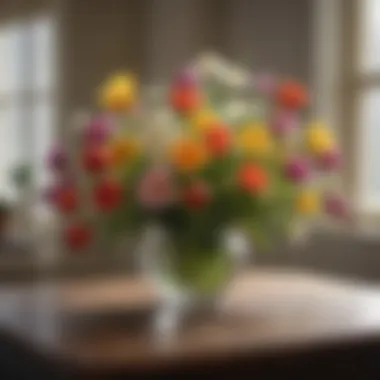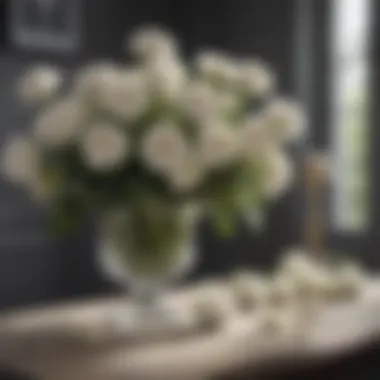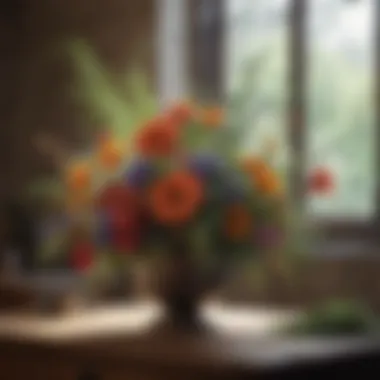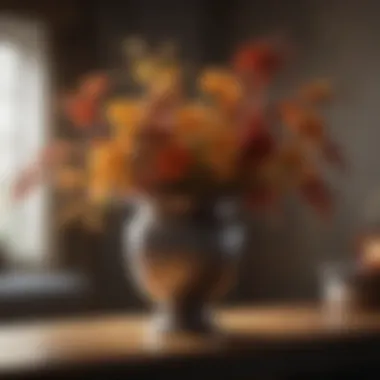Explore Trendy Floral Arrangements for Modern Spaces


Intro
Design Inspiration
Trending Styles
Current trends in floral arrangements demonstrate that there is artistry in simplicity. Minimalistic designs have gained popularity. Think of clean lines and a limited variety of flowers, emphasizing each bloom's innate beauty. Another trend is to incorporate asymmetry, which adds dynamic appeal to any display.
Organic forms are also prominent. Arrangements that mimic the shapes found in nature create a relaxed feel. The use of mixed mediums, such as incorporating elements like driftwood, pebbles, or glass, adds texture. Furthermore, emphasizing seasonal blooms is on the rise. Using local flowers benefits aesthetics, and it reduces the carbon footprint associated with transportation.
Color Palettes
Color plays a critical role in the emotional and visual impact of floral arrangements. Soft, muted tones like pastel pinks and light greens create a calming effect. On the other hand, vibrant colors can energize a space. Balancing colors is essential; a monochromatic scheme can be quite effective if implemented with various shades and textures of the same hue.
When selecting a palette, consider the purpose of the arrangement. For formal settings, richer colors often signify elegance. In contrast, lighter shades are suitable for casual settings or everyday use. Mixing complementary colors introduces energy and excitement, while analogous colors create harmony.
"Choosing the right color scheme can elevate your arrangements, ensuring they harmonize with your overall design aesthetic."
Practical Tips
Maintenance & Care
Once you have crafted a stunning arrangement, its longevity depends significantly on maintenance. Regularly changing the water helps keep flowers fresh. Additionally, trimming the stems at an angle allows for better water absorption. Some flowers require particular care, such as being kept in cooler environments, which can prolong their life span.
Budgeting & Planning
Creating beautiful floral arrangements does not have to be prohibitively expensive. Planning is key. First, establish a budget and stick to it. Consider using bulk flowers, which are often more affordable than pre-arranged options. You can also explore local growers or farmer's markets for fresh, affordable blooms. Additionally, planning can help you utilize flowers from your own garden or even consider dried flowers, which offer durability and an aesthetic appeal of their own.
Prelims to Floral Arrangements
Floral arrangements hold significant value in transforming spaces and creating atmospheres. Understanding the fundamentals of floral design provides insights into composition, style, and the emotional impact of flowers. The importance of this topic cannot be understated in today’s design-focused world. A well-crafted floral arrangement can elevate any setting—be it a cozy home or an elegant event.
In this article, we will explore the various dimensions of floral arrangements, focusing on how trendy designs can reflect personal aesthetics while addressing current trends, sustainability, and practical techniques. Readers will learn how to select appropriate seasonal blooms and utilize color theory to create harmonious pieces. Moreover, the article emphasizes the benefits of understanding these elements, leading to more thoughtful and creative design choices.
Historical Context
The history of floral arrangements dates back thousands of years. Different cultures utilized flowers for various reasons—rituals, celebrations, and aesthetics. The ancient Egyptians, for instance, were among the first to employ flowers in meaningful arrangements. They used flowers to honor their gods and embellish tombs. Similarly, ancient Greeks valued flowers not only for their natural beauty but also for their symbolism.
As societies evolved, so did the styles of floral design. In medieval Europe, floral arrangements became a sign of status and prosperity. Noble families often displayed lavish arrangements at feasts and events, showing off their wealth and taste. The Renaissance period marked a shift to more structured and artistic approaches, establishing guidelines that influenced modern design.
Evolution of Floral Design
Floral design has undergone significant transformations over time. The late 19th and early 20th centuries saw the emergence of the Victorian style, characterized by tightly packed blooms and elaborate styles. This era influenced many traditional floral practices that are still prevalent today.
Throughout the 20th century, modernism introduced simplicity and functionality into floral design. Minimalism gained popularity, moving away from ornate arrangements. The focus shifted to individual flowers, appreciating their unique form and beauty. This evolution paved the way for contemporary floral arrangements, which emphasize creativity, sustainability, and personal expression.
It is essential to recognize the shift in floral design, as it reflects broader societal changes in values, aesthetics, and sustainability.
These historical contexts lay the foundation for understanding current trends in floral arrangements. Knowledge of the past enriches one's approach to modern designs, leading to more innovative and meaningful creations.
Understanding Current Trends
In the realm of floral design, understanding current trends is crucial for both aesthetic enhancement and creating meaningful connections through nature. Trends in floral arrangements are reflective of broader cultural shifts, tastes, and environmental awareness. Adapting to these trends can transform a simple arrangement into a statement that resonates with the viewer. This segment will cover two significant trends: minimalism and biophilic design influence, showcasing how they impact the way flowers are used in homes and events.
Minimalism in Floral Design


Minimalism in floral design has gained traction as people increasingly seek simplicity and clean aesthetics. This trend emphasizes the beauty of fewer elements, allowing each flower to shine. Arrangements often consist of a limited selection of blooms, highlighting their uniqueness without overwhelming the viewer.
- Benefits of Minimalism:
- Simplicity: Achieving elegance with less can lead to peaceful living spaces.
- Cost-Effective: Fewer flowers mean lower costs, making it accessible for many.
- Timeless Appeal: Minimalism is often more adaptable to changing tastes over time.
Common characteristics of minimalist arrangements include:
- Monochromatic color schemes, which utilize different shades of a single color to create harmony.
- Geometric vases that complement the floral design without taking attention away from the flowers.
- Strategic placement of blooms, allowing negative space to enhance visual interest.
Biophilic Design Influence
Biophilic design is an emerging trend in floral arrangements that emphasizes the connection between humans and nature. This approach incorporates natural elements into the environment, aiming to enhance well-being and foster a sense of calm. With increasing urbanization, many individuals seek ways to bring the soothing presence of nature into their homes.
Key aspects of biophilic design in floral arrangements include:
- Natural Materials: Using organic materials, like wood or stone, alongside floral elements.
- Dynamic Compositions: Incorporating a variety of plant life, such as foliage, branches, and seasonal blooms to mimic natural ecosystems.
- Health Benefits: Research suggests that being surrounded by plants can reduce stress and improve mental health.
"Incorporating biophilic design can transform ordinary spaces into calming retreats, fostering a deeper appreciation for nature."
Understanding these trends encourages homeowners, designers, and event planners to explore innovative ways to arrange flowers. By embracing minimalism and biophilic influences, they can create stunning displays that not only serve as decoration but also contribute positively to their surroundings.
Elements of Trendy Arrangements
Seasonal Blooms
Seasonal blooms are flowers that are at their peak during specific times of the year. They offer several benefits that elevate floral arrangements. First, using seasonal flowers often consists of economically viable choices since they are abundantly available. This contributes to better affordability and freshness. Second, they naturally align with the environment and the prevailing colors of the season, helping to create more harmonious designs.
These flowers also give a sense of authenticity to an arrangement. For instance, peonies in spring or sunflowers in summer not only enrich the display but also echo nature's cycles. As a homeowner or designer, incorporating these blooms can enhance the connection between indoor and outdoor spaces while maintaining a relevant decor theme.
Color Theory in Arrangements
Color plays a fundamental role in floral design. It influences mood and perceptions. Understanding how to use color effectively can enhance the visual appeal of arrangements.
Complementary Colors
Complementary colors are those located opposite on the color wheel. This specific aspect creates contrast that draws attention. By pairing colors like orange with blue or yellow with purple, arrangements become eye-catching and dynamic. The key characteristic of complementary colors is their ability to highlight each other, making the flowers stand out.
These colors can evoke strong emotions and increase the vibrancy of the arrangement. However, caution is needed. Overuse of contrasting colors might lead to visual chaos instead of harmony. Thus, balance is crucial when implementing this color scheme in trendy floral designs.
Monochromatic Schemes
Monochromatic schemes involve variations of a single color. This choice leads to serene and elegant arrangements. The key characteristic of monochromatic schemes is simplicity. By using different shades, tones, and tints of one hue, the arrangement can possess depth while maintaining visual cohesiveness.
This scheme is beneficial because it provides a timeless aesthetic. A blend of white flowers, for instance, can create a delicate and sophisticated atmosphere. However, solely relying on one color may limit vibrancy and may seem flat without adequate texture and form variations. It's vital to intersperse textural differences to ensure visual interest alongside color depth.
Textural Variation
Textural variation is pivotal in floral arrangements. This involves incorporating flowers and foliage with diverse textures, such as soft petals of roses juxtaposed against the ruggedness of thistles. The contrast between textures adds dimension to the arrangement. It also keeps the viewer's interest, drawing attention to different elements.
Utilizing a mix of textures can enhance the life and perceived complexity of an arrangement. Textures work hand in hand with colors and forms, helping to create a complete visual story. When arranging flowers, experiment by combining smooth, glossy leaves with matte surfaces. This interplay can infuse life into any arrangement, crafting a vibrant yet coherent floral statement.
Sustainable Floral Practices
Sustainable floral practices are increasingly important in today’s world of floral design. As more individuals become conscious of their environmental impact, the floral industry is adapting by promoting methods that are not only aesthetically pleasing but also responsible. Integrating sustainability into floral arrangements involves several key factors, including sourcing local blooms and utilizing eco-friendly packaging. These practices not only help reduce the carbon footprint but also support local economies and enhance the beauty of arrangements with fresh, seasonal flowers.
Sourcing Local Blooms


Sourcing local blooms plays a crucial role in creating sustainable floral arrangements. Buying flowers from local growers reduces the need for long-distance transportation, which significantly lowers carbon emissions associated with shipping. Moreover, locally sourced flowers are often picked at peak freshness. This results in longer-lasting arrangements.
Additionally, supporting local floriculture contributes to the local economy. It fosters a sense of community and encourages biodiversity. Various flowers are grown in different regions, enhancing the diversity of options available. Homeowners can further personalize their arrangements by choosing flowers that are in season and readily available.
"Choosing local flowers not only benefits the earth but also connects people to their surroundings in a deeper way."
Eco-Friendly Packaging
The packaging of floral arrangements contributes significantly to sustainability. Traditional plastic wraps and foam materials are not biodegradable and pose environmental hazards. Transitioning to eco-friendly packaging options reduces waste and promotes a greener outlook. Alternatives include recyclable materials, biodegradable wraps, and compostable containers.
Furthermore, many floral designers and shops now offer reusable containers, encouraging customers to return for refills or new arrangements. This not only reduces waste but also enhances customer loyalty.
Additional sustainable practices include:
- Reducing single-use plastics.
- Using natural dyes for packaging.
- Implementing minimalistic designs that require less material.
By adopting these eco-friendly packing strategies, the floral design industry can decrease its overall environmental impact and thrive in a more sustainable way.
Practical Tips for Home Arrangements
Creating beautiful floral arrangements at home is not only about choosing the right flowers, but also about understanding how to display and maintain them. These practical tips help homeowners and enthusiasts alike to elevate their space with vibrant displays. A well-crafted arrangement can serve as a focal point in a room, add warmth, and express personal style. It is essential to consider the elements of design, sizing, and care to ensure that the arrangements remain stunning over time.
Choosing the Right Vase
Selecting the appropriate vase is critical to the success of a floral arrangement. A vase acts as the foundation, supporting both the visual balance and the longevity of the arrangement. Here are some key considerations when choosing a vase:
- Size Matters: A vase should complement the size of the arrangement. For tall arrangements, opt for a taller vase, and for smaller bouquets, a short or medium vase can be effective.
- Shape Consideration: Different shapes serve different floral styles. A narrow neck vase is ideal for structured arrangements, while wider openings allow for more relaxed, natural looks.
- Material Selection: The material of the vase can impact the overall presentation. Glass vases are classic and allow for a clear view of the stems. Ceramic and stoneware options provide more texture and may enhance color palette.
- Color Coordination: Consider the colors of both the flowers and the vase. A neutral vase can enhance vibrant flowers, while a colorful vase can bring added dimension to a monochrome floral scheme.
Arranging Techniques for Balance
Achieving visual balance in floral arrangements is crucial. Here are techniques to create harmony in your designs:
- Rule of Thirds: Divide the vase into thirds. Place the tallest stems at the back and shorter flowers in front to create depth.
- Group by Color: Cluster similar colors together. This creates a cohesive look that draws the eye naturally across the arrangement.
- Vary Heights: Use stems of different lengths to create movement and interest. Taller flowers can be paired with lower blooms to break the line and add layers.
- Shape and Form: Combine flowers with varying shapes—such as round blooms with spiky elements. This contrast can enhance the overall appeal.
Balance in floral design is not merely aesthetic; it serves a functional purpose, drawing the eye and creating emotional resonance in a space.
Maintenance and Care
Proper care ensures floral arrangements remain fresh and vibrant. Implement these tips for longevity:
- Water Quality: Use clean, room-temperature water. Add flower food if available, as it contains nutrients that help flowers thrive.
- Regular Trimming: Trim stems at an angle every few days. This increases surface area for water absorption.
- Environmental Conditions: Keep arrangements away from direct sunlight, heat sources, and drafts. This helps reduce wilting and maintains freshness.
- Remove Dying Blooms: Regularly check for and remove wilting flowers. This not only enhances appearance but also prevents mold formation in the water.
Following these practical tips can significantly enhance the visual impact of floral arrangements in any home. With careful selection of vases, thoughtful arranging techniques, and proper maintenance, achieving stunning displays is within reach for anyone.
Floral Arrangements for Events
Floral arrangements for events play a crucial role in setting the ambiance and tone of any gathering. They serve not just as decor but also as a reflection of the event's purpose and the host's personality. From weddings to corporate gatherings, the importance of selecting the right arrangements cannot be overstated. Well-crafted floral displays can enhance the visual appeal, create a welcoming atmosphere, and even influence the emotions of the guests.
Careful consideration is necessary when planning floral decor for events. Factors include the venue, the seasonality of blooms, and the overall color theme of the event. Flowers can evoke feelings, marking moments in time, so choosing seasonal and locally sourced blooms can also resonate with sustainability values that many people prioritize today.
Weddings and Celebrations
Weddings and celebrations are perhaps the most recognized realms for floral arrangements. The choice of flowers can reflect the couple’s personal tastes and establish the wedding's theme. For instance, soft pastel flowers can lend a romantic atmosphere, while bold, vibrant blooms might complement a more energetic celebration.
An effective floral arrangement for weddings typically involves accentuating the ceremony and reception spaces. Some key elements to keep in mind include:
- Bridal Bouquets: These are often the centerpiece of floral design. They should reflect the bride's style while matching the wedding theme.
- Centerpieces: These should be eye-catching yet not obstructive. Consider height and size to ensure they facilitate conversation across the table.
- Ceremony Décor: This includes altar arrangements and aisle markers. They should create a stunning backdrop for photographs.
- Floral Archways: These are particularly trendy, creating stunning entrances that are perfect for social media sharing.


Good planning and execution help make these arrangements memorable, leaving a lasting impression on guests while accentuating the special moments of the day.
Corporate Events
Floral arrangements for corporate events serve a different purpose but are just as essential. They create a professional yet inviting atmosphere that can facilitate networking and discussions. The key is to strike a balance between sophistication and approachability.
Some considerations for corporate floral arrangements include:
- Brand Alignment: The colors and types of flowers can reflect the company's branding. Incorporating corporate colors into the floral displays can reinforce brand identity.
- Formal vs. Casual: Depending on the nature of the event, arrangements can range from minimalist and sleek to lush and vibrant. Understanding the event's tone is key.
- Placement: Arrangements should strategically be placed in high-visibility areas, such as reception desks, dining areas, and meeting rooms.
- Eco-friendly Designs: Incorporating sustainable practices can enhance a company's reputation. Using locally sourced flowers can show commitment to environmental responsibility.
Floral arrangements in a corporate setting are more than just decoration; they serve as a catalyst for connections and conversations among attendees.
In summary, the impact of floral arrangements at events cannot be overlooked. They enhance aesthetics, communicate messages, and create intimate and memorable experiences for guests.
Incorporating Technology in Floral Design
The integration of technology into floral design signifies a major shift in how arrangements are created, marketed, and enjoyed. This section focuses on the critical aspects of this transformation, highlighting how technology enhances creativity, efficiency, and accessibility in floral arrangements. Homeowners and designers alike benefit from these advancements, as they enable more precise and innovative designs that respond to individual taste while considering practical needs.
With the rise of digital platforms, floral design has transcended traditional methods, allowing for greater experimentation and personalization. This evolution means that information and resources are widely accessible. Real-time trends can now influence design choices, improving the relationships between customers and florists. Furthermore, technology aids in operation efficiency, helping florists streamline their work processes.
Digital Design Tools
Digital design tools are pivotal in modern floral arrangements. They allow designers to visualize their concepts before execution, minimizing trial and error. Tools such as Adobe Illustrator and various 3D modeling software offer features that enable florists to create detailed layouts and color schematics.
- Visual Conceptualization: Designers can create mock-ups of arrangements. This step aids in evaluating proportions, color balance, and style cohesiveness.
- Color Palette Selection: Design software helps in experimenting with different color combinations quickly. This uniqueness caters to individual tastes.
- Increased Accuracy: These tools ensure precise dimensions, reducing waste and promoting better resource management.
Incorporating these digital tools leads to an efficient workflow and encourages innovation in floral design.
Online Floral Marketplaces
The rise of online floral marketplaces has changed how consumers purchase flowers and arrangements. Websites like ProFlowers and 1-800-Flowers present a diverse selection of floral products that cater to various tastes, seasonality, and occasions.
- Accessibility: Customers can browse a wide selection of flowers from the comfort of their homes. This convenience enhances the shopping experience and makes floral arrangements more reachable.
- Customization Options: Many online platforms allow consumers to personalize their arrangements. They can choose specific flowers, colors, and styles that suit their needs. This direct involvement offers customers a sense of ownership over their floral displays.
- Networking Opportunities: For florists, these marketplaces provide exposure to a broader audience. They can showcase their designs and attract potential clients who may otherwise not discover their work.
Innovation continues to shape the floral industry. By embracing technology, florists can adapt to new trends and consumer demands, ultimately enriching the experience for all involved.
"Technology has revolutionized floral design, making it not just an art, but a comprehensive experience that marries creativity with accessibility."
Closure and Future Directions
One key benefit of embracing trendy floral designs is the ability to create spaces that resonate personally with the homeowner or designer. This means using flowers not just for decoration but also to convey emotions and themes relevant to the occasion or the atmosphere one wishes to establish.
Moreover, it is crucial to consider the implications of sustainability in floral arrangements. In the future, we foresee a rise in demand for locally sourced blooms and eco-friendly practices. This trend not only helps in reducing carbon footprints but also supports local economies. As awareness grows, consumers might prioritize florists who share these sustainability values.
It is worth considering how technology can continue to impact floral design. Digital tools for layouts and design will likely evolve, making it easier for individuals to visualize their ideas before execution. These innovations can bridge the gap between traditional methods and modern expectations, creating an era of floral arrangements that are both beautiful and thoughtfully designed.
"Staying ahead of emerging trends allows for the infusion of fresh ideas that can elevate floral design to new heights, encouraging designers to think outside the box."
Emerging Trends to Watch
The floral arrangement landscape is in constant flux, and it is vital to stay informed about emerging trends. One notable trend is the use of dried flowers. They offer a long-lasting alternative that requires less maintenance, making them a popular choice among busy individuals. Furthermore, the soft hues and textures they provide contribute to a rustic and vintage aesthetic that appeals to many.
Another trend gaining traction is the incorporation of unusual flowers and foliage. Flowers such as proteas and anthuriums are moving to the forefront, along with unique greens like eucalyptus and ruscus. The boldness of these choices is changing the way arrangements are viewed, allowing for a more avant-garde approach.
Moreover, biophilic design, which emphasizes the connection between humans and nature, is influencing floral arrangements. People are integrating plant elements into interiors in ways that enhance emotional well-being. Arrangements that incorporate living plants may play a crucial role in future designs.
Encouraging Creativity in Floral Design
Creativity in floral design is not merely an aesthetic pursuit but a way to express individuality and emotions. To encourage creativity, one should begin with a clear understanding of principles like balance, proportion, and visual weight. These elements serve as guidelines while allowing for personal expression.
Experimentation is essential. Homeowners and designers should feel free to mix conventional blooms with unconventional ones, playing with shapes and sizes to create unique looks. It’s also beneficial to step outside one's comfort zone—different styles, like asymmetrical arrangements or cascade designs, can offer the opportunity for innovation.
Journaling or sketching floral ideas can also stimulate creative thoughts. Documenting arrangements or inspirations can serve as a pool of ideas that might ignite new concepts when design inspiration is needed.















